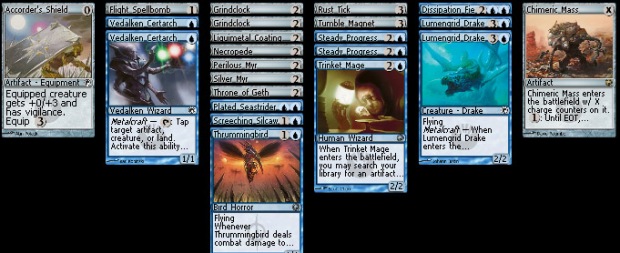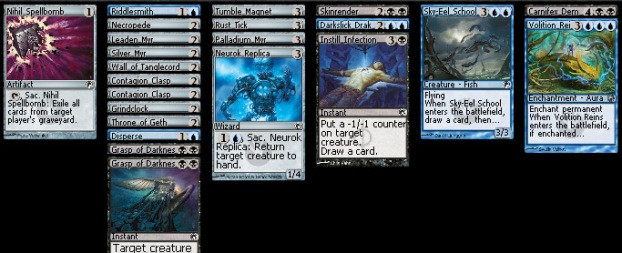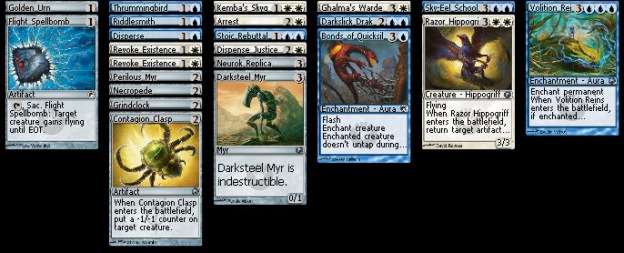How do you feel when you sit down for a draft and open this pack?
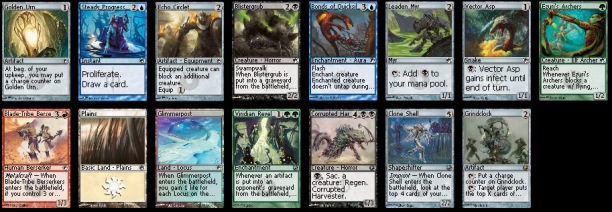
You
might groan and sigh at your terrible luck and reluctantly place the Leaden Myr into your pile.
I
cackle with glee as I windmill slam the Grindclock. Today, I’m going to share my enthusiasm for this unloved rare.
When two people play a game of Magic, it’s common that both people try to win the same way, knocking the other player’s life to zero. When I’m playing Mill, it’s as though I’m playing another game that my opponent doesn’t know about. By the time he finds out he’s playing my game, he’s losing. There are few feelings I find more satisfying than watching my opponent’s face as he literally runs out of options.
The draft above was one of the most fun times I’ve had playing Scars of Mirrodin draft. The problem with dedicated Mill in Scars Draft is it’s isolated to four cards: Grindclock at rare, Geth along with Sword of Body and Mind at mythic, and Screeching Silcaw at common. With the mythics unlikely to show and Silcaw being plain terrible, if I want to play a sweet Mill deck in Scars Limited, I’m stuck happily grinding out the time with one of the most Johnny Mill cards ever printed.
The Grindclock math can be a little complicated and is heavily reliant on landing the clock on turn 2. As Grindclock is underrated, there are fairly good odds that the rest of the draft pod will ignore it, and it will wheel into my hot little hands, allowing me to get multiple copies, but I never count on this happening. However I’m willing to take the rare over other more stable options. Thankfully, the cards I want to support this deck aren’t popular and often will wheel as well.
The most optimal play for using a Grindclock has been discussed in a wide range of forums such as Twitter,
Zvi’s set review,
and
reddit.
In most cases, assuming I can get the clock into play on turn 2 and my opponent doesn’t draw more than one card a turn or puts cards back into their library (currently, no way to do that exists in Scars Limited), then four charges of the clock before milling is the “optimal” play.
The problem is four charges of the clock takes
forever.
Sure, it’s a clock, but it’s an exceedingly slow clock. The key to the Grindclock deck lies in solving this dilemma. How can I either speed the clock up, or slow the game down long enough that the Grindclock will win me the game?
If I’m slowing the game down long enough and dictating the speed of the game, it means I’m the control deck. Grindclock is a control deck and is easily my favorite control archetype in this format. I’m denying you options, I’m preventing your attacks. I’m slowly pressing for a victory. Control decks make your opponent play their game by your rules.
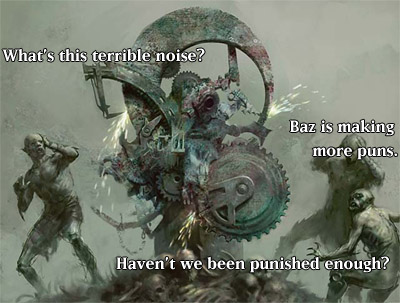
Winding the Clock Forward
The easiest ways to accelerate my Grindclock are either extra mill effects or proliferating the Clock to give it more counters. As I’ve said, Geth, Lord of the Vault, Sword of Body and Mind, and Screeching Silcaw are the only other mill cards in the set.
Geth, as a mythic, has a tendency to win the game on his own. A 5/5 intimidator with built-in card advantage is going to win a game long before I can mill my opponent out. With Geth, the mill is more of a side effect to getting a creature than a win condition. If I swing with Geth and any creatures he’s recruited, I’ll kill my opponent faster than Mill ever will.
Just like Geth, Sword of Body and Mind is a mythic, and will win every game if unanswered. You will win games off the Mill trigger in Limited most of the time. The card is clearly the nuts, and I’d be a fool if I passed it. The card sort of makes Grindclock redundant since two hits from the Sword and your opponent is basically milled out, which is a shame for the Clock.
Screeching Silcaw is a very mediocre Mill card. There are too many “whens” and “ifs” for me to actually like the card enough to pick it. However, the card is playable (barely) even if I’m not intending on bashing through for the Mill effect, as he blocks one of the key creatures in Scars Limited, Plague Stinger, profitably (and I use the term very loosely, since he becomes as useless as a Lightning Bolt against a Kor Firewalker after a single block).
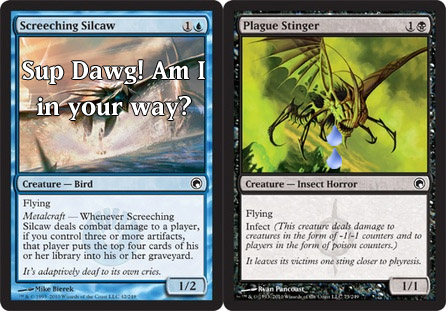
If, however, I get him to connect with an opponent whilst metalcraft is active, I can wipe a whole turn of four-counter Grindclock activations off their deck. For Silcaw to work, my priority is achieving metalcraft first, then finding a way to introduce his beak to my opponent’s face. Neurok Invisimancer is one of the finer ways to accomplish this. Once again, I won’t rely on Silcaw for speeding up the clock, but he can, occasionally, sometimes, be a big help.
The second way I wind the clock forward is with the assistance of proliferate effects. Steady Progress is fantastic. I think of it as my Swiss army knife in this archetype. It accelerates my Grindclock, charges my other artifacts, and even digs for your Grindclock if I don’t have it, since it cantrips. It just does everything I need.
The real gems of the proliferators are the repeatable use cards. Thrummingbird is a star in the Grindclock archetype. This little birdie told me he’s the only proliferator that doesn’t require a constant input of resources to do its job, which makes his value in the archetype rocket skyward since he won’t tie up my mana. He’s cheap, flies, and the damage means he won’t likely be seen as a threat by my opponent.
I like sitting on the Throne of Geth; although it can be a bit pointy, since it’s made of the bones of the dead. The throne can throw away my useless chump blockers or Spellbombs for incredible value. Sacrificing Perilous Myr or Necropede can also come in handy for clearing the board of undesirable creatures.
Inexorable Tide is easily the most potent of proliferators as it can be activated multiple times a turn. However the down payment is expensive, and it requires a constant stream of spells to be truly effective. It has the largest proliferation potential, but the highest cost and effort required. For the tide to turn in its favor, I need to have a large number of cheap cantripping spells such as Twisted Image or Spellbombs. The problem is the more do-nothing cards I add, the worse my deck is. The tide isn’t coming in on this occasion, and if I obtain a copy in the draft, it’s generally too much effort to build around.
I’m down to the last two proliferators and I’ve saved the best for last, Contagion Clasp and Contagion Engine. Both are positively bonkers in almost any deck, which means I pick these extremely high, regardless of the deck. Both are windmill slams, no exceptions, they’re just that good. The proliferate cost of four mana may seem a lot, but since the cards themselves generate their own supply of counters to begin with, they provide exceptional value.
The advantages to picking up the proliferators in this deck is they also provide me with an alternate win condition if I happen to pick up an infect creature such as Ichorclaw Myr or Necropede. This won’t make me a dedicated infect deck. However, there’ll be times when I’m more likely to poison someone than clocking them in the face, so a second win condition is something I look for.
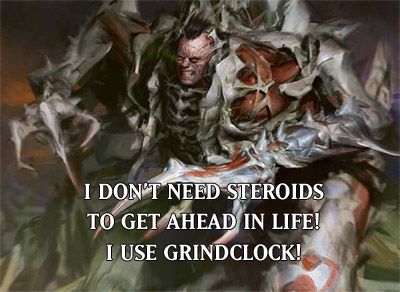
Matrix-style Slow Motion
Next, I look at how I can slow the game down long enough that I can draw the Grindclock, charge it, and use it. The answer lies in gumming up the ground with fat-bottomed creatures and bad enchantments.
Enchantments such as Dissipation Field rise in value in this archetype because, while I can’t afford to take copious amounts of damage each turn, the Field effectively doubles the amount of time between each attack, while also putting pressure on my opponent’s mana, forcing them to recast each creature multiple times each turn. Dissipation Field buys me time, which is exactly what the clock needs.
However, the Field can also backfire spectacularly by allowing my opponent to abuse certain “enter the battlefield” triggers that obliterate this archetype. Buyer beware, and I’m careful to side it out if needed. Intelligent play is always going to be required when playing any blue-based deck, especially in this format.
Bonds of Quicksilver may be expensive but locking down a creature in Blue often comes at a premium. Sometimes you just have to pay the bond. Bonds of Quicksilver isn’t a permanent solution to a creature, nor does it let you forget the creature exists. I’ve seen so many people cast a Bonds of Quicksilver then ignore the enchanted creature. They get the shock of their lives when their horde of artifacts starts getting smelted.
Blue has some of the best defensive creatures in the set. I want cards like Vedalken Certarch and Neurok Replica so I can wreak havoc on my opponent’s board position. The problem is they have hoops to jump through. The best creatures to halt my opponent’s progress for this archetype are ones that again require no additional investment.
Wall of Tanglecord is fantastic in this deck. It blocks all day and short of an infect guy or Shatter will stick around the entire time. By playing or splashing green, he can also gum up the air. In mono-blue, Plated Seastrider being a 1/4, having a huge rear for its cost, and blocking half the creatures in the format without dying.
Darkslick Drake is one of the best blue fliers to play defense, and I’ll pick it highly. It also has a very large rear end and discourages death since your opponent is rarely interested in allowing you to profit from a trade. If I can reach metalcraft, Lumengrid Drake becomes a bounce sorcery with a 2/2 flier attached, which, depending on what I’m bouncing, can be fantastic value.
Sky-Eel School is equally good on offense and defense, and very good at defending the sky, but is far more expensive than most of the creatures I want to block. It does, however, give me an alternate win condition, something I’m sure to bear in mind.
Blue also offers some protective cards for my Grindclock and proliferate engine cards. Turn Aside becomes playable when it counters every artifact removal spell besides Oxidda Scrapmelter or Sylvok Replica for the low, low price of one mana. Stoic Rebuttal counters everything and anything, while Halt Order does exactly that to artifacts.
These are all cards I want to play and pick highly. Of course, I realize I’ve mentioned almost every single blue card in the set. Blue is criminally under-drafted in this format. The problem is that blue is stuck between the R/W Metalcraft decks and the G/B Infect decks. Blue doesn’t naturally gravitate to either archetype, but both I and my friends have had tremendous success with mono-blue. So when you can’t find an archetype for blue, you make a new one yourself — mono-blue evasive metalcraft control!
Here’s an example of a Mono-Blue Grindclock list:
Feeling Blue
The Grindclock deck is plenty good as a mono-blue deck, but there will be times where I want the support of another “better” color. After all, the Boy Scouts motto is “Be Prepared.”
If so, this is the order I like the other support colors in this archetype.
1.     Black
2.     White
3.     Red
4.     Green
Black brings the most to the table; with minimal infector support, I can add another layer of pressure on my opponent’s clock. Suddenly my opponent is racing both my Grindclock and their poison total. Additionally, cards like Skinrender and Grasp of Darkness give me the tools to survive the opponent’s onslaught and turn the game in my favor. Even Instill Infection helps buy me the time I need to mill out my opponent while spreading a sea of counter love. Sharing is caring after all.
Here’s an example of one of my successful U/B Grindclock drafts:
White gives me the most protection for my Grindclock, letting me get it back with cards like Salvage Scout and Razor Hippogriff. At the same time, it also gives me great removal with Arrest and Revoke Existence. Life gain cards such as Kemba’s Skyguard and Trigon of Mending also come into their own when all I’m concerned about is buying time.
In the same vein, Golden Urn is fantastic (even though it isn’t white) as it’s a cheap artifact for metalcraft effects, gains life, uses charge counters, and sacrifices itself for recursion. I’ve become a fan of the Urn in recent times and suggest you try it out when you get a chance.
This draft wasn’t as successful as the other two lists I’ve shared today, but I still feel it’s a great example of how I’d draft the U/W Clock deck.
Red and green both don’t have a lot to offer the counter-generation or milling parts of the deck, but generally provide effective removal or blockers. Green brings extra infect men to the table, with Tel-Jilad Fallen providing an excellent defensive dude who plays well with proliferate.
Red brings sweet burn spells like Arc Trail and Galvanic Blast as well as great artifact destruction like Oxidda Scrapmelter and Shatter. Taking cards like these also mean my opponent can’t scrap my plans for a huge Clock in the middle of the table, ticking down to the moment when my opponent goes insane.
I haven’t drafted U/G or U/R as a dedicated Grindclock deck. However, I’ve had success with general U/R control decks that play a Grindclock as a control tool. If you were to look at the Grindclock deck as an overarching Blue Proliferate archetype, there are other cards you can use in place of the Grindclock to try and win the game.
If I didn’t have Grindclock in my deck (which defeats the purpose of the archetype obviously), I’d reluctantly have Necrogen Censer fill the void — ten activations, and your opponent is done. You can, of course, accelerate that clock easier by just bashing, but who wants to do a thing like that? Oh…. right… everyone but me.
I’d be remanded if I didn’t talk about other awesome artifacts that just get insane in this deck. Tumble Magnet becomes insane if you can proliferate every turn with a reusable effect, like Contagion Clasp. Super Icy Manipulator, anyone? The only Trigon I really want for the deck is Trigon of Corruption. Vomiting -1/-1 counters I can proliferate? Sign me up!
The indestructible Darksteel Myr and Darksteel Sentinel are awesome keeping the ground under control. Naturally, they’re useless against infect. We can’t have it all I suppose. Golem Foundry is very hard to use efficiently, but if you have the critical mass of proliferate effects, you can spew 3/3 Golem tokens out until your opponent dies. Our deck wants lots of strong defensive creatures as I’ve discussed in previous sections.
Any artifact that relies on charge counters to do its thing is going to be one worth looking at. Lux Cannon is clearly a very powerful tool for controlling the board. Once again, having that mass of proliferate effects will turn our Lux Cannon into a Lux Rail Gun. It’s not hard to decide whether a card is good. Thankfully, the format has evolved enough that we all know an insane card to draft when we see one. Precursor Golem? Insane. Mimic Vat? Plain nutty. Wurmcoil Engine? Crikey!
While I prefer to build the archetype around Grindclock, you can’t use the Clock to win every game every time. Sometimes, the Clock will be relegated to perform its ancillary functions while you bash face with whatever bomb rare you opened later on. Even when you’re in that situation, Grindclock can still be useful in preparing for the next game.
Clocking Out
In Limited, information is power. If I know what my opponent’s deck contains, I can make more effective plays and sideboard more answers in. If I can find out the contents of my opponent’s deck, while at the same time denying my opponent the use of those cards, the world is all peaches and rainbows. Grindclock does its job, and it does it well. It provides a singular threat that your opponent on occasion won’t consider actually being one.
I’ve found Mill effects to be far more potent when playing Magic in person. There’s something rather visceral about your opponent putting his cards into the graveyard one by one. I think the opponent pays more attention to the effect in person because of the physical action involved. I find a large number of players on Magic Online are caught out by the size of their deck and freak out when they realize it.
I hope you’ve enjoyed this look at an unloved rare, and I hope you can find the time to vote for me.
Until next time, keep an eye on the time.
Baz
@thatdamnaussie on Twitter
BazD on Magic Online

